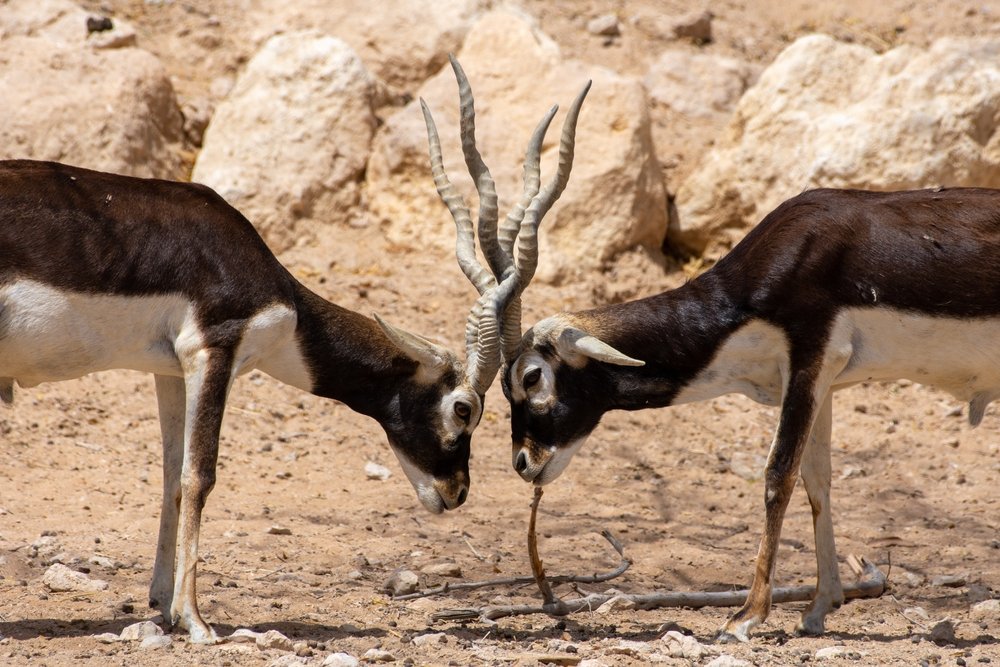Blackbuck National Park: Where Graceful Antelopes Roam the Golden Grasslands

Blackbuck National Park, situated in Velavadar within the Bhavnagar District of Gujarat state, India, was established in 1976 in the Bhal region of Saurashtra. Located about 42 km from the district headquarters city of Bhavnagar, the park hugs the coasts of the Gulf of Khambhat to the south, spreading across an area of 34.08 km2. Originally a “vidi” (grassland) reserved for the maharaja of the princely state of Bhavnagar and his famous hunting cheetahs, the park is surrounded by wastelands and agriculture fields on the northern side. Classified as a 4B Gujarat-Rajwada biotic province of the semi-arid bio-geographical zone, it boasts flat land, dry grasses, and herds of antelope that have consistently drawn visitors.
This park, with its grassland ecosystem, serves as a haven for wildlife conservation. Ongoing programs focus on the protection of the blackbuck, wolf, and the lesser florican, a bustard species native to India. The lesser florican, once widespread across the country, is now endangered, with the park hosting the largest population of this endemic Indian species.
As you explore, observe the success of conservation initiatives, reflected in the increasing numbers of local wolves and frequent sightings of the elusive striped hyena during daylight in winter 2012-2013. Blackbuck National Park stands as a testament to the delicate balance between nature’s resilience and the commitment to preserving India’s unique biodiversity.
Geographical
In July 1976, when the park was established, the initial protected area covered approximately 18 km2. By 1980, an additional 16 km2 were incorporated, expanding the total area to 34.08 km2.
A significant southern portion of the park, bordering the Gulf of Khambhat, lies within the Gulf’s high tide zone and experiences periodic inundation with water. Despite this seasonal inundation during the monsoon, the park’s semi-arid conditions persist, creating unique habitats conducive to the diverse fauna that depend on the park’s ecosystem.
History
The history of Blackbuck National Park is a rich tapestry woven with significant milestones in its establishment and dedicated conservation initiatives. Here’s a concise overview of its historical journey:
Hunting Ground of the Maharaja:
In times past, the present-day Blackbuck National Park, also known as Velavadar National Park, was a “vidi” (grassland) belonging to the maharaja of the princely state of Bhavnagar in Gujarat. This expansive grassland served as the maharaja’s exclusive hunting ground, where he engaged in pursuits of blackbucks, accompanied by his renowned hunting cheetahs.
Recognizing the imperative to shield the blackbuck population from rampant hunting and habitat degradation, the area underwent a pivotal transformation in the early 20th century. It was officially declared a reserve forest, signifying a commitment to safeguarding the blackbucks and preserving their natural habitat for long-term sustenance.
Wildlife Sanctuary Status: As awareness and concerns regarding wildlife conservation escalated, the area’s crucial role as a habitat for blackbucks became increasingly evident. In 1972, it attained the status of a wildlife sanctuary, providing elevated protection for the blackbuck species. This marked a crucial juncture in the park’s history, highlighting a growing dedication to conserving its unique ecosystem.
Establishment as Blackbuck National Park: Building upon its designation as a wildlife sanctuary, the year 1976 witnessed the formal establishment of Blackbuck National Park. This marked a transformative step, solidifying its identity as a dedicated conservation area exclusively focused on the preservation and well-being of blackbucks. The national park status facilitated more comprehensive management, intensified conservation efforts, and dedicated research for the blackbuck population.
The historical trajectory of Blackbuck National Park, evolving from a hunting ground to a protected reserve forest, and subsequently becoming a wildlife sanctuary and national park, reflects the changing perspectives on wildlife conservation. Today, the park stands as a testament to the successful endeavors undertaken to protect the blackbuck population, ensuring they thrive in a secure and flourishing environment.
Flora
Situated amidst the expansive grasslands of Gujarat, India, Blackbuck National Park showcases a diverse array of flora, predominantly composed of dry grasses (60%), shrubs (15%), and thorny bushes. The park’s ecosystem has adeptly adapted to the arid climate, featuring vegetation well-suited to endure the region’s harsh weather conditions.
Here are some notable flora species flourishing within the park:
(1) Grasses: The park’s extensive grasslands are dominated by various species, including Cenchrus ciliaris (buffel grass), Pennisetum Pedicellatum, and Aristida Adscensionis. These grasses play a vital role by providing essential grazing resources for blackbucks and other herbivores inhabiting the park.
(2) Shrubs and Scrubs: Thriving in the park’s scrublands are several shrubs and scrubs that have adapted to the arid conditions of the region. Common species include Ziziphus nummularia (ber), various Acacia species, Salvadora persica (toothbrush tree), Prosopis juliflora (mesquite), and Calligonum polygonoides (bluebush). These resilient plants contribute significantly to the overall biodiversity of the park, each playing a unique role in maintaining the delicate balance of the ecosystem.
Fauna
Blackbuck National Park, also recognized as Velavadar National Park, harbors a diverse array of fauna, encompassing various mammal, bird, and reptile species. The park is a sanctuary for a multitude of wildlife, and here are some noteworthy examples of the fauna that inhabit this natural haven:
Mammals
- Blackbucks
- Wolves
- Hyenas
- Foxes
- Bluebull (Nilgai)
- Wild Boar
- Jackals
- Jungle Cats
- Wild Pig
- Hares
Birds
- Lesser Floricans
- Macqueen’s Bustards
- Houbara Bustard
- White Stork
- Harriers
- Sarus Cranes
- Common Kestrel
- Peregrine Falcon
- Eurasian Hobby
Reptiles
- Indian Cobra
- Russell’s Viper
- Saw-scaled Viper
How to Reach
By Air: The most convenient way to visit Velavadar Blackbuck National Park is by air. The closest airport is Bhavnagar Airport in Bhavnagar, just 65 kilometers from the park, with a well-connected road network.
By Rail: Bhavnagar railway station is the nearest rail hub to Velavadar National Park, serving as a crucial transit point for visitors.
By Road: Major cities are connected to Blackbuck National Park via an extensive road transportation network. Since the Indian government permits it, private vehicles are also permitted to enter the national park.
Best time to visit (December to February)
Early winter is the best time to visit when wetland is not dry, to watch birds as well with blackbuck, deers, wild boar.
Things To Do
Exploring Blackbuck National Park presents a variety of activities for nature enthusiasts and wildlife lovers. Here are some experiences you can enjoy in the park:
- Wildlife Safari: Embark on a thrilling wildlife safari to witness the diverse flora and fauna, including the iconic blackbucks, in their natural habitat.
- Bird Watching: Delight in the avian wonders of the park by engaging in bird watching. The park is a haven for various bird species, providing a rewarding experience for bird enthusiasts.
- Nature Walk: Immerse yourself in the natural beauty of the park with a tranquil nature walk. Discover the unique landscapes and observe the fascinating flora and fauna up close.
- Photography: Capture the mesmerizing beauty of the park through photography. The diverse wildlife and scenic vistas offer excellent opportunities for photography enthusiasts.
- Camping: Experience the serenity of the park by camping amidst nature. Enjoy the night sounds and the starry skies for a memorable outdoor adventure.
- Visit the Interpretation Centre: Enhance your understanding of the park’s ecosystem by visiting the Interpretation Centre. Learn about the wildlife, conservation efforts, and the park’s significance.
- Visit the Velavadar Village: Explore the nearby Velavadar Village to experience local culture and immerse yourself in the rural surroundings.
- Stargazing: Unwind under the night sky and indulge in stargazing. The park’s tranquil ambiance provides an ideal setting for observing the celestial wonders above.
Conclusion
Blackbuck National Park stands as a beacon of hope for wildlife conservation in India. Once hunting grounds, its golden grasslands have transformed into a haven for majestic blackbucks, elusive wolves, and vibrant birdlife. This transformation is a testament to the power of conservation, proving that even the most fragile ecosystems can be restored.
Beyond its ecological importance, Blackbuck National Park offers a unique tapestry of experiences for tourists. Thrill seekers can chase the wind on jeep safaris, nature lovers can unravel the secrets of the grasslands on guided walks, and photographers can capture the essence of the wild through their lens. For those seeking cultural immersion, the park welcomes visitors to the Velavadar Village, where they can experience the warmth and traditions of the Rabari community.
Blackbuck National Park is more than just a park; it’s a call to action. It invites us to respect wildlife, protect natural habitats, and appreciate the interconnectedness of all things. So, pack your sense of adventure and embark on your own Blackbuck journey. Witness the grace of the blackbuck, listen to the symphony of the grasslands, and let the magic of this place ignite your passion for the wild. Blackbuck National Park awaits, ready to paint your soul with the vibrant colors of nature and the enduring spirit of conservation.
FAQ
The park’s combination of diverse fauna, vibrant grasslands, rich cultural heritage, and accessible conservation efforts sets it apart. Witnessing the success story of blackbuck conservation firsthand and experiencing the harmonious relationship between people and wildlife makes Blackbuck National Park a truly special place.
Yes! Several organizations and park initiatives welcome volunteers to assist with research projects, educational programs, and conservation efforts. Contact the park authorities or relevant NGOs to explore potential volunteer opportunities and contribute your skills to protecting this vital ecosystem.
Besides the graceful blackbucks, the park boasts exciting predators like wolves, striped hyenas, and foxes. Gentle giants like bluebulls (nilgai) and wild boars graze alongside smaller hunters like golden jackals and jungle cats. Don’t forget the speedy hares and essential rodent populations!
The park remains open through the year, but the monsoon season (July-September) brings heavy rains and potential road closures. The ideal time to visit depends on your preferred wildlife sightings and weather conditions.
Responsible tourism is key! Respect the wildlife by maintaining distance, avoid littering, and follow park regulations. Stay on designated trails to minimize disturbance and use vehicles responsibly. Remember, your actions can impact the park’s delicate ecosystem.
Limited accommodation options are available within the park itself, including forest guesthouses and tented camps. Nearby towns like Bhavnagar and Bhavnagar offer a wider range of hotels and resorts. Plan your stay in advance during peak season.
Sun protection like sunscreen and a hat are essential, especially during the dry season. Comfortable shoes for exploring the grasslands, binoculars for wildlife viewing, and water bottles are necessary. Consider insect repellent and light clothing in warmer months.
The blackbuck itself is a testament to successful conservation efforts. Once on the brink of extinction, their numbers have risen due to habitat protection and controlled hunting. Similar programs are in place for the endangered lesser florican, offering hope for the future of these graceful birds.
